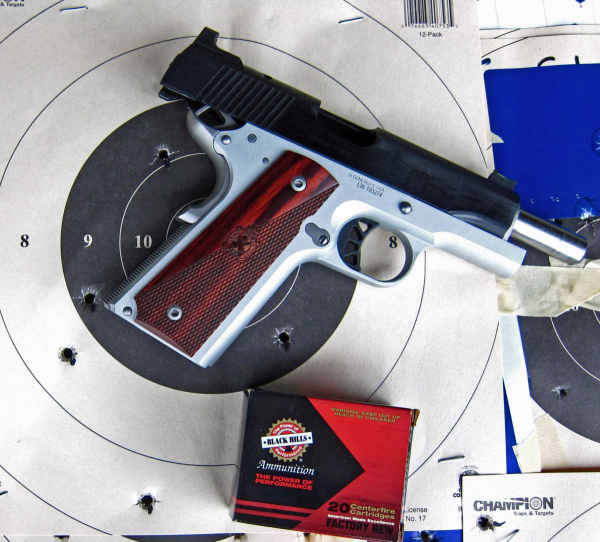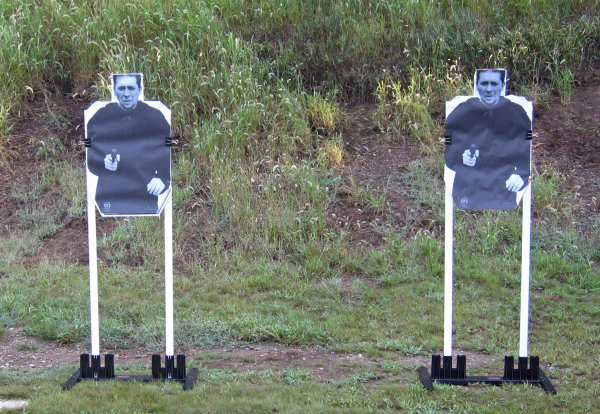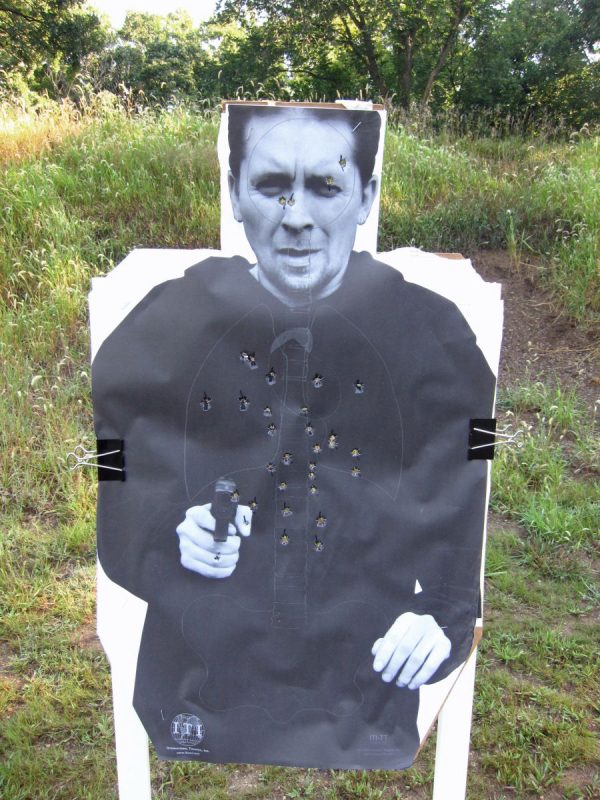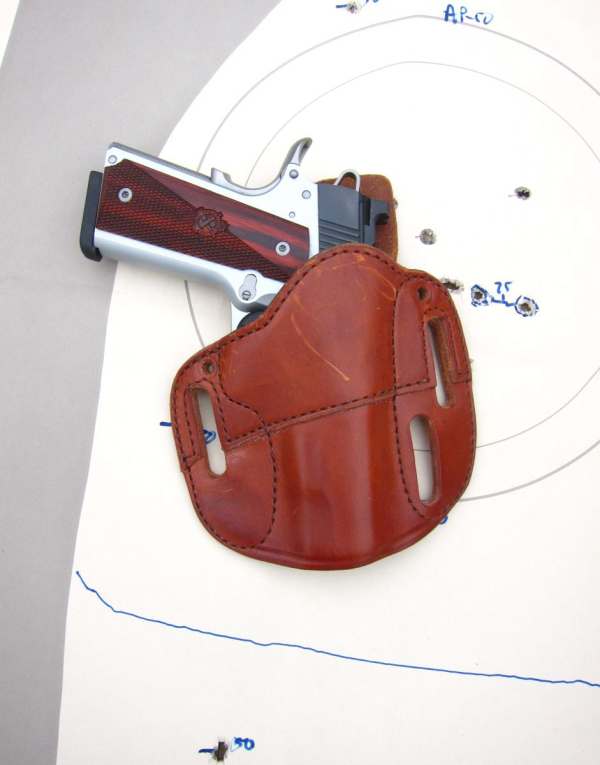If you’re keeping up, you saw coverage of a small part of the Springfield Armory 1911 AOS line here last week. The Ronin was the 1911 line I selected from and I arranged to get a slick-top lightweight Ronin AOS, 4 ¼” (so-called “Commander” right down to the aluminum frame) in 9mm as well.
The Ronin 4 ¼” AOS 9mm featured a lightweight aluminum alloy frame and ramped barrel. The rear sight – part of the optics cover plate – was blank with a U-notch. The front sight is fiber optic – I’d prefer a night sight.


The gun is light, sub-30 oz empty, short enough to be quicker out of a holster, but not so short it’s hard to shoot well. It has all the “Commander” advantages.
On a rushed, non-typical range trip (on a weekend before the IDPA crowd ran a match), I tried the Ronin 4 ¼” Lightweight AOS – with iron sights – from a seated rest at 25 yards. Five rounds of Black Hills 115gr. JHP-EXP stretched over six inches of vertical spread. The thin stocks and my failing grip contributed to the group size. The best three hits clustered into 3 5/8” – which wasn’t bad for 25 yards.
The first Ronin pistol received had a Trijicon RMR mounted at the factory. A 41-ounce 9mm pistol – featuring a stainless receiver and blued slide, all very nicely done – has a five-inch stainless barrel with an integral ramp, appropriate for a 9mm 1911.
Using Galco’s Avenger belt holster which (like their Concealable 2.0) is cut for optics-mounted pistols now, I used an “operator’s course” inspired by J.W. Parent, military and industry trainer, to evaluate both AOS Ronin guns. It’s all fired at seven yards (absent a “shooting on the move” stage) on two targets. The course features two targets, 22 rounds of ammunition, draws, a timed reload and time malfunction, high percentage hits and can be run as a “time only” course, with added seconds for misses and points down. It can also be run as a par time course with points on target and penalties for hits outside or over-time hits. I adjusted the course for the 9- and 10-round magazines (Springfield Armory, Brownells and Wilson Combat) I was using. Parent’s course was for 15-17 shot guns.


I found my times were slightly better on some stages with the lightweight Ronin with no optic. I shot it second, so it’s likely “training effect” and not a reflection of a lack of experience with the RMR. The difference in time taken for each stage was so minimal, it was effectively even money.
The steel Ronin was steady and sure. The light Ronin was agile and quick. They each have advantages.
Neither handgun has had a stoppage that wasn’t intentionally induced.
On a following trip with the slick-top lightweight Ronin, I used Sellier & Bellot 115 grain FMJ to shoot an analog state qual course up close, then moved back. I shot the new gun back to fifty yards. This thing sings to me.
Easy to shoot, it’s still reliable. At fifty yards, all hits were ‘in the bottle’ on the IALEFI-Q target. My point of aim was the top of the circles. I had one hit to the left of that point, one in the circle (low), two below the circle and one under the drawn-in “waist line.”


That’s not great shooting, but that’s not the gun’s fault. And I didn’t miss.
Up close, shooting “bent-elbow” in the ICE-FPS qualification style, all hits landed in the circles. I had one head shot just off the circle.
On this final trip, the holster I used was from Simply Rugged, the DEFCON-3 holster – a pancake holster with improvements. These include a reinforced holster mouth to keep the rig from collapsing when the gun is drawn, three 1.75” slots to fit appropriate belts on his Chesty Puller Straps (chest field rig) and a raised tab to keep the gun off of your skin. The holster is provided with a pair of straps that screw onto the holster and allow wear inside the waist. It has the footprint of the currently fashionable hybrid holsters but it is a leather holster.
The AOS system is innovative, the pistols are finely made and fitted. If you’re a 1911 fan but you have a hankering to use optics, Springfield Armory has some interesting products for you.
Specifications, 1911 RONIN 4.25" AOS (from Springfield Armory)
Part# PX9118LAOS
COLOR: Blued / Satin Aluminum
BARREL: 4.25" Forged Stainless Steel, Match Grade, Fully Supported Ramp, 1:16
SLIDE: Forged Carbon Steel, Blued, Optics-Ready
FRAME: Forged Aluminum Alloy, Satin Aluminum Cerakote
SIGHTS: Fiber Optic Front, Tactical Rack White Dot Rear
RECOIL SYSTEM: Commander Length GI Style
GRIPS: Crossed Cannon Wood Laminate
MAGAZINES: (1) 9-Round
WEIGHT: 29.5 oz
LENGTH: 7.9"
HEIGHT: 5.5"
— Rich Grassi